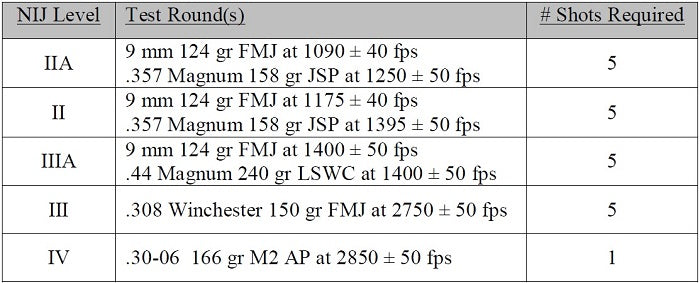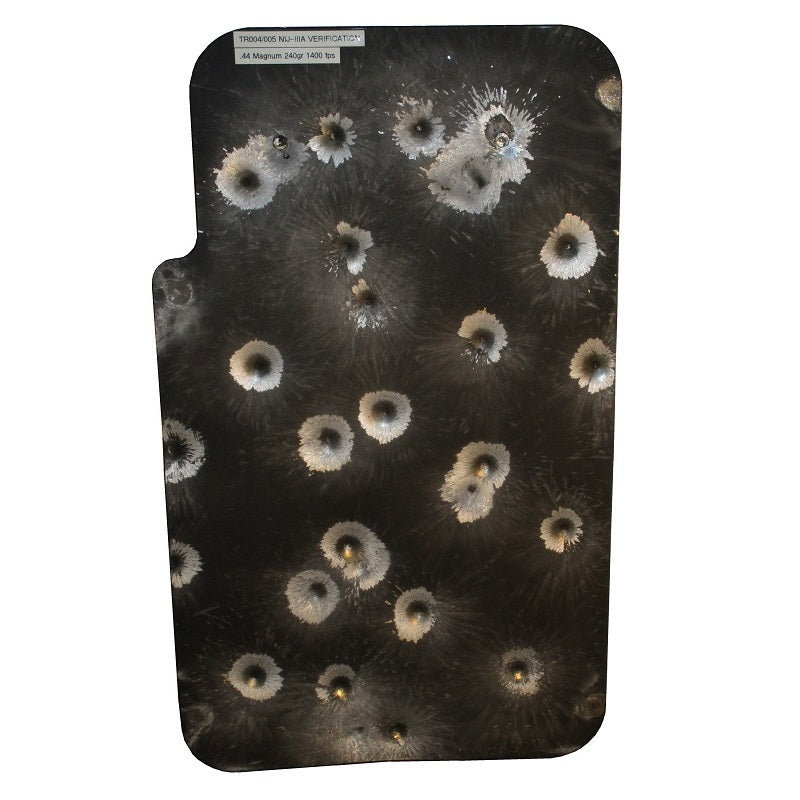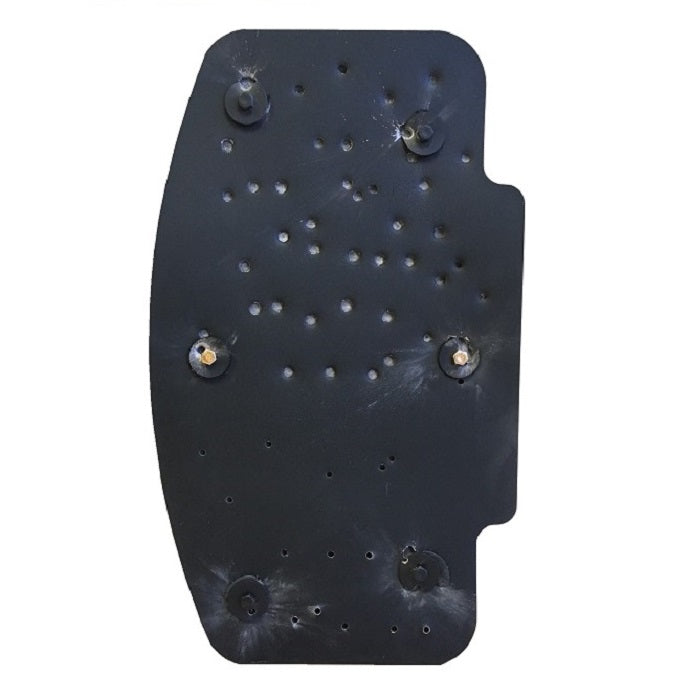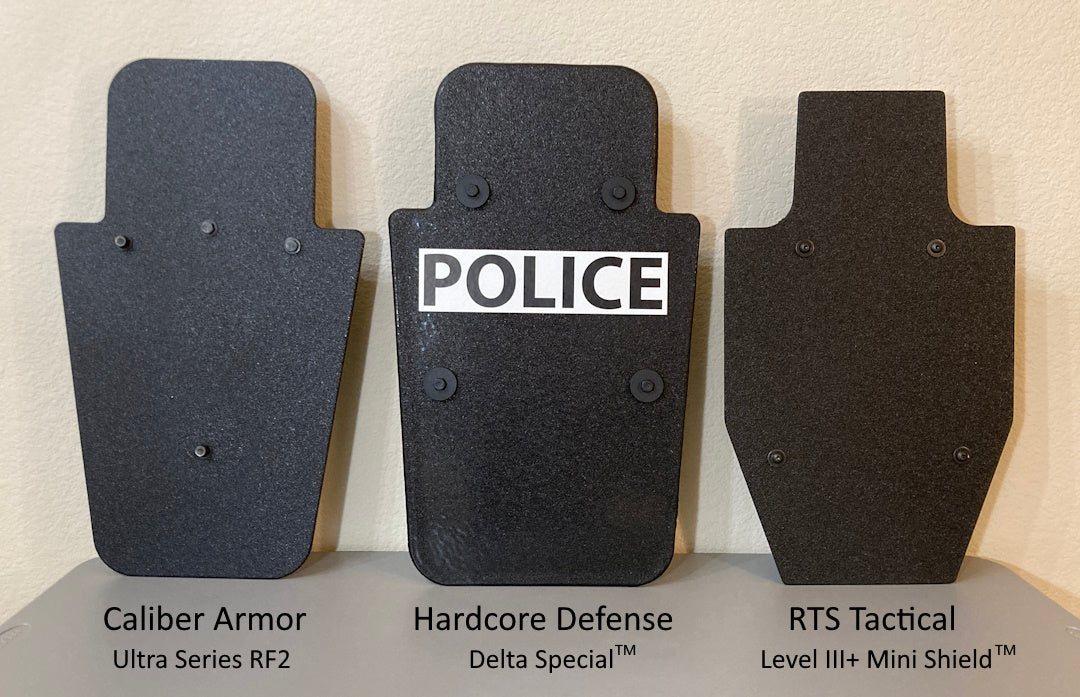Testing
Read this before you buy any ballistic protection product!
The National Institutes of Justice, a branch of the Department of Justice, establishes the U.S. standards for ballistic testing of body armor and other ballistic protection products. NIJ Standard 0101 specifies testing for body armor, and NIJ Standard 0108 specifies testing for other ballistic protective materials including shields. The standards are identical in terms of threat level definitions, and vary with respect to fixturing of test devices and acceptance criteria. Soft armor is tested over a clay block and a maximum of 44 mm of blunt trauma deformation is considered acceptable, while ballistic shields and similar items are tested with a witness plate behind them to confirm penetration of any projectile or fragment.

There are currently five commonly used threat levels specified in the current NIJ standards, as shown in the adjacent table. NIJ I for .22 Long Rifle and .38 Special is effectively obsolete.
The NIJ is currently in the process of updating these standards and have published a draft 0101.7 standard with "HG1" and "HG2" handgun protection levels, and "RF1", "RF2", and "RF3" protection levels. The updated standard is still being refined and has not been implemented yet.
As can be seen in the table above, the common 5.56x45 mm round is not specified at any particular threat level. NIJ Level III armors and shields may NOT stop the 5.56x45 mm round. Always ensure any product intended to stop rifle fire has been specifically tested against both the M193 55 grain FMJ and the M855 (SS109) 62 grain green tip penetrator 5.56x45 mm rounds at real world velocities. NIJ Level III only requires resistance versus the .308 Winchester (7.62x51 mm) round. While the .308 has more kinetic energy than the 5.56x45 mm round, it is larger diameter and slower and does not penetrate many ballistic materials as well as the 5.56x45 mm.
Note that the 5.56 mm M855 green tip "penetrator" bullet performs surprisingly poorly against hardened steel since the steel bullet tip is comparatively soft and breaks up upon striking ballistic steel, slowing down the energy transfer from the bullet to the shield. Testing the M855 is no substitute for testing the M193. Against ballistic steel the M193 has a rapid energy transfer and a different failure mode. Some companies don't test their products against the M193 because they know it may penetrate their AR grade steel. Only against ballistic fiber products is the M855 is the greater threat.
NIJ Level III products should easily stop the 7.62x39 mm round, and many armor manufacturers add this round to their testing in order to claim an "NIJ III+" protection level. NIJ III+ is not an official NIJ threat level and does not necessarily mean any improved performance over NIJ III. Read the fine print in any product description to ensure the product was tested against both 5.56 mm rounds before you buy.
NIJ Level IV will stop both 5.56x45 mm rounds with ease, although if it is a ceramic-based product multi-hit performance may be suboptimal.
NIJ Testing Limitations
The NIJ standards are useful in providing standardized testing benchmarks and procedures for industry. They do have limitations though which product buyers should be aware of:
- The standards from the 1980s and the threat rounds specified are not the ones most likely to be encountered anymore.
- The standards only require a material sample to be tested, not the final product. For a ballistic shield this means that any windows, handle anchors, and other potentially weak areas are not required to be tested.
- The standards only require the sample to resist FIVE strikes from each test round. That is insufficient for the real world! Passing 5 for 5 statistically provides only a 54% assurance that a 6th shot won't penetrate (with 95% confidence). In the case of NIJ Level IV, only ONE round is tested and must be stopped (almost all Level IV products use ceramics, and it is assumed that the ceramic was shattered by the first strike and would be unreliable at stopping additional strikes.)
- The standards require the test rounds to be spaced at least 2" from each other and 2" from the edge of the panel. Because ballistic fiber materials need a healthy fabric of fibers to distribute the kinetic energy from a bullet strike, hits within 2" of a previous hit or within 2" of the edge of the panel MAY PENETRATE. Even if they do not, the blunt trauma would be increased in these areas.
Hardcore Defense Testing
All Hardcore Defense products are tested by an independent test lab in accordance with the NIJ standard. We then perform significant additional internal testing on our shield products to verify that each design meets our company goal of having the absolute toughest and most reliable products available. Our protocol for this is as follows:
- We test only the final product, not a material sample.
- We test each shield design against a minimum of 30 strikes per threat round, which is sufficient to statistically support a 90% reliability level that the material can resist each individual threat round. Actual reliability may be higher.
- We require at least 1 strike from each threat round directly on or within 1" of the handle bolt.
- We require at least 3 strikes from each threat round within 1" of another strike.
- We require at least 3 strikes from each threat round within 1" of the edge of the shield.
Our testing has shown that all of our shields can take a hits from their rated test rounds directly on the bolt heads. All shields have demonstrated the ability to withstand hits to within 0.5" of a prior hit or to the edge of a shield (0.75" for M80 vs Bravo shield). Hits closer than 0.5" (0.75") to a prior hit or to the edge of the shield may penetrate. Note that bolt hit, multi-hit, and edge hit data is from small sample sizes for indicative purposes only and does not represent any statistical assurance level.
No Games
We don't play games with our testing. The NIJ standard allows a +/- 50 fps window around the target velocity. We know of other companies that handload each shot to be within a few fps of the bottom end of the window, cherry pick the steel lot to be used for validation, and also rely on the 50' test distance to further soften the blow so they just barely "pass". Is it legal? Technically yes. But do you really want that product when faced with an armed assailant? We have also heard of companies taking advantage of using the draft status of the RF1/2/3 specifications and setting their own velocity tolerance windows for testing. Or they use the wrong test standard. For the record:
- NIJ 0101 is for body armor
- NIJ 0106 is for helmets
- NIJ 0108 is for ballistic shields

The Alpha Advantage
Here's what an Alpha Shield™ looks like after absorbing thirty stout NIJ IIIA .44 Magnum test rounds per the above protocol. Most of what you see is lead splash blasting off the powder coating; deformation is only occurring in the dark circles in the middle of each strike. The shield is fully functional, with no cracks and a maximum backface deformation of about 1/4".

Bravo Tough
And here's what one of our Bravo Shields™ looked like after absorbing over sixty 5.56x45 mm M193 and M855 test rounds on a single shield! The upper strikes with the wider tears in the titanium facing layer were the M855 hits, while the lower strikes with the clean hole in the titanium were the M193 hits. In all cases the bullets fragmented upon hitting the steel core, with the majority of the debris trapped between the layers.
One Delta Shield likewise successfully absorbed over 60 5.56x45 mm and 7.62x39 mm hits, before we switched to heavier calibers and kept shooting it until we started to see significant failures (hence no picture).

Dominate with Delta
And how does our popular Delta shield family compare to the competitors? See for yourself!
Quality Control
We utilize a comprehensive quality system to ensure our manufacturing operations yield the same quality products day after day, year after year. Our current complaint rate is less than 0.1%, and we have never had a product recall.
Hardcore Defense strives to maintain a lean and efficient manufacturing operation and corporate organization, such that we can provide you the best products at the best prices.
